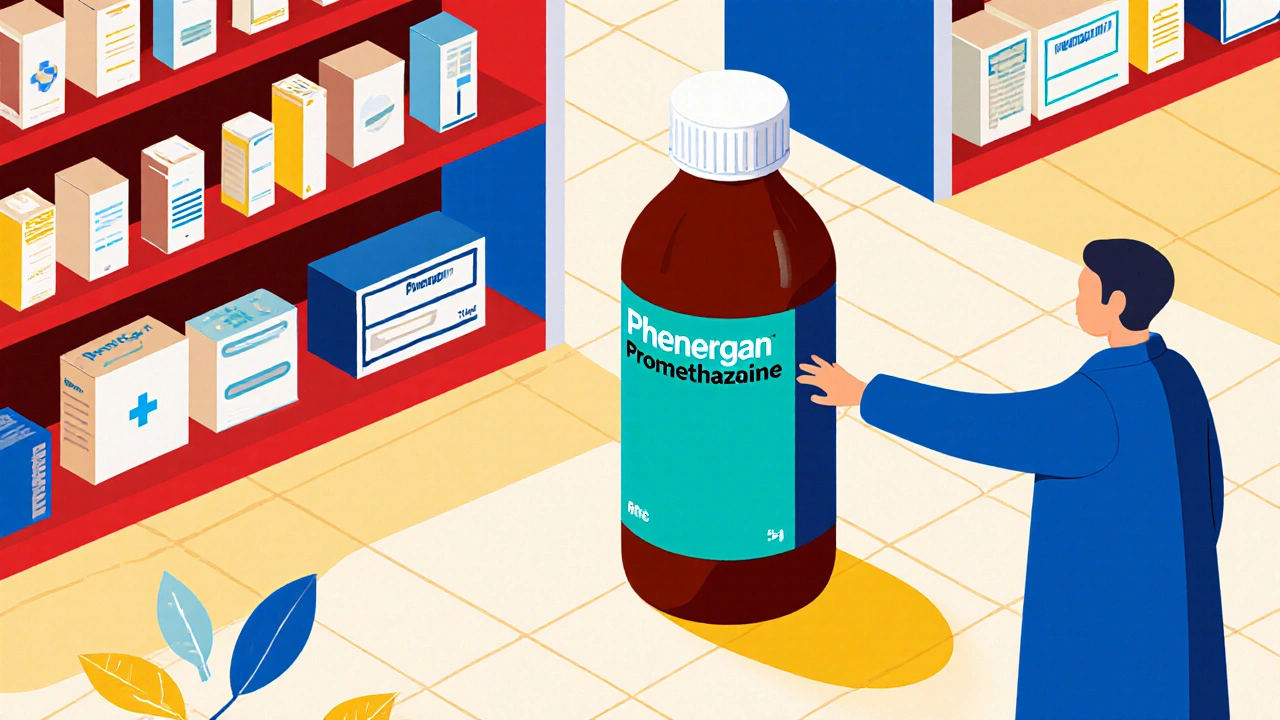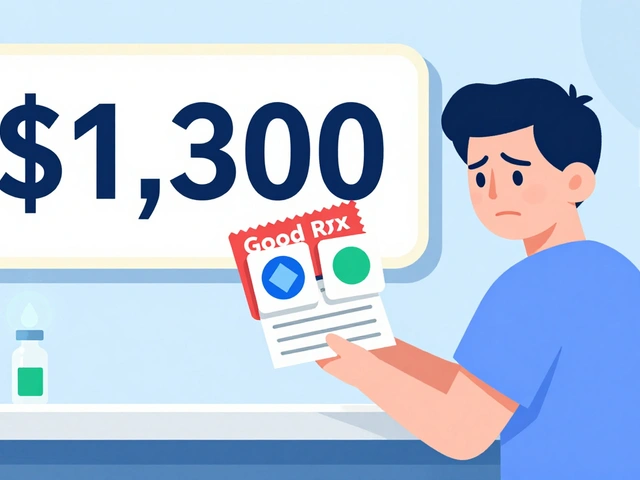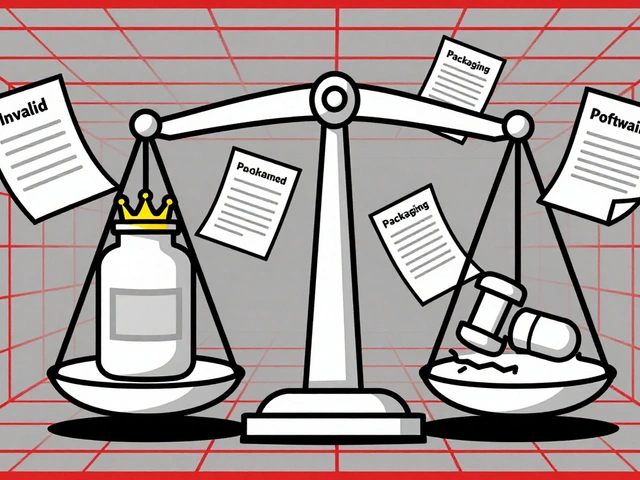Antihistamine Recommendation Tool
Find Your Best Antihistamine
Answer a few questions to get personalized recommendations for your symptoms and lifestyle.
Did you know that more than 30 million Americans use Phenergan every year for everything from motion sickness to severe itching? If you’re scrolling through pharmacy aisles or online drug databases, you’ll quickly wonder whether a different antihistamine might work better for you. This guide breaks down Phenergan (promethazine) and lines it up against the most common alternatives, so you can decide what fits your symptoms, lifestyle, and safety needs.
What is Phenergan (Promethazine)?
Phenergan is a first‑generation antihistamine and anti‑emetic. It’s also marketed under the generic name Promethazine and has been on the market since the 1950s. The drug works by blocking H1 histamine receptors in the brain and peripheral tissues, which reduces allergic reactions, and by antagonizing muscarinic receptors, which helps control nausea.
How Phenergan Works - Mechanism in Plain English
When you encounter an allergen, your body releases histamine, which triggers itching, swelling, and hives. Phenergan binds to the same receptors histamine would attach to, basically putting a “Do Not Disturb” sign on them. At the same time, its anticholinergic action slows the signals that tell your stomach to vomit, making it a go‑to choice for motion sickness and post‑operative nausea.
Typical Uses and Dosage Forms
- Allergy relief - oral tablets 6.25 mg to 25 mg, or injectable 12.5 mg/ml.
- Pre‑operative sedation - 12.5 mg to 25 mg IM/IV.
- Control of nausea and vomiting - 12.5 mg every 4-6 hours as needed.
- Sleep aid for severe itching - 12.5 mg at bedtime.
Because the drug can cause strong drowsiness, doctors often prescribe the lowest effective dose and advise patients not to drive or operate machinery.
Major Side Effects & Safety Warnings
Phenergan is effective, but it carries a notable side‑effect profile:
- Intense sedation - up to 6 hours of sleepiness.
- Dry mouth, blurred vision, and urinary retention (anticholinergic effects).
- Rare but serious: extrapyramidal symptoms (tremor, rigidity) especially in children.
- Possible respiratory depression when combined with opioids or alcohol.
If you have glaucoma, enlarged prostate, or a history of seizures, discuss alternatives with your clinician.
Why Consider Alternatives?
Not everyone tolerates the heavy sedation or anticholinergic load that Phenergan brings. Some patients need a faster‑acting antihistamine for daytime allergy relief, while others prefer an over‑the‑counter (OTC) option without a prescription. Below we explore five popular alternatives and where each shines.

Alternative #1 - Diphenhydramine (Benadryl)
Diphenhydramine is a first‑generation antihistamine best known by its brand name Benadryl. It blocks H1 receptors like Phenergan but has a shorter half‑life (4-6 hours) and is widely available OTC.
- Typical dose: 25‑50 mg every 4-6 hours.
- Onset: 15‑30 minutes.
- Durability: 4‑6 hours.
- Side effects: Similar sedation, but usually less intense than Phenergan.
Alternative #2 - Hydroxyzine (Atarax/Vistaril)
Hydroxyzine is a prescription‑only antihistamine sold under Atarax or Vistaril. It offers strong anti‑itch properties with a slightly milder sedative effect than Phenergan.
- Typical dose: 25‑100 mg up to three times daily.
- Onset: 20‑30 minutes.
- Duration: 4‑6 hours.
- Unique benefit: Can be used as an anxiolytic in low doses.
Alternative #3 - Chlorpheniramine (Chlor‑Trimeton)
Chlorpheniramine is another first‑generation antihistamine, often marketed as Chlor‑Trimeton. It’s less sedating than Phenergan and works well for daytime allergy relief.
- Typical dose: 4 mg every 4-6 hours (max 24 mg/24 h).
- Onset: 30‑60 minutes.
- Duration: 6‑8 hours.
- Side effects: Mild drowsiness, dry mouth.
Alternative #4 - Levocetirizine (Xyzal)
Levocetirizine is a second‑generation antihistamine sold as Xyzal. It provides 24‑hour relief with minimal sedation, making it ideal for chronic allergic rhinitis.
- Typical dose: 5 mg once daily.
- Onset: 1‑2 hours.
- Duration: 24 hours.
- Side effects: Rarely drowsy; occasional headache.
Alternative #5 - Meclizine (Bonine)
Meclizine is an OTC antihistamine marketed as Bonine or Antivert. It’s primarily used for motion sickness and vertigo, with a low sedation profile compared with Phenergan.
- Typical dose: 25 mg one hour before travel; repeat every 24 hours if needed.
- Onset: 30‑60 minutes.
- Duration: 24 hours.
- Side effects: Light sleepiness in ~10 % of users.

Side‑by‑Side Comparison Table
| Drug | Prescription? | Typical Indication | Onset | Duration | Sedation Level | Anticholinergic Load |
|---|---|---|---|---|---|---|
| Phenergan (Promethazine) | Yes | Severe allergy, nausea, pre‑op sedation | 15‑30 min | 4‑6 h | High | High |
| Diphenhydramine (Benadryl) | No | Allergy, short‑term sleep aid | 15‑30 min | 4‑6 h | Moderate‑High | Moderate |
| Hydroxyzine (Atarax/Vistaril) | Yes | Itch, anxiety, pre‑op sedation | 20‑30 min | 4‑6 h | Moderate | Moderate |
| Chlorpheniramine (Chlor‑Trimeton) | No | Daytime allergy | 30‑60 min | 6‑8 h | Low‑Moderate | Low |
| Levocetirizine (Xyzal) | No | Chronic allergic rhinitis | 1‑2 h | 24 h | Low | Low |
| Meclizine (Bonine) | No | Motion sickness, vertigo | 30‑60 min | 24 h | Low‑Moderate | Low |
Pros & Cons - Quick Verdicts
- Phenergan: Best for severe allergic reactions and nausea, but brings strong drowsiness and anticholinergic side effects.
- Diphenhydramine: Easy OTC access, fast onset, but still quite sleepy - good for occasional allergy spikes.
- Hydroxyzine: Prescription strength with added anxiety‑relief benefits; moderate sedation makes it suitable for nighttime itching.
- Chlorpheniramine: Lightest sedation among first‑generations; ideal for daytime work or school.
- Levocetirizine: Near‑zero drowsiness, long‑lasting control; perfect for chronic hay fever.
- Meclizine: Tailored for motion sickness with minimal daytime sleepiness.
How to Choose the Right Antihistamine for You
- Identify the primary symptom. If nausea is dominant, Phenergan or Hydroxyzine are top picks; for chronic sneezing, Levocetirizine shines.
- Consider the time of day. Daytime work calls for low‑sedation options (Levocetirizine, Chlorpheniramine). Nighttime itch may tolerate higher sedation (Phenergan, Hydroxyzine).
- Check prescription requirements. OTC options save doctor visits, but prescription drugs may be needed for stronger effects.
- Review personal health factors. History of glaucoma, prostate issues, or seizure disorder tips the scale toward low‑anticholinergic agents like Levocetirizine.
- Test a short trial. Start with the lowest dose; if side effects are intolerable, switch to the next alternative on the list.
Quick Comparison Checklist
- Do you need rapid onset (< 30 min)? Choose Phenergan, Diphenhydramine, or Hydroxyzine.
- Is 24‑hour coverage essential? Levocetirizine or Meclizine.
- Can you tolerate prescription‑only meds? Hydroxyzine offers extra anxiety relief.
- Are you sensitive to drowsiness? Prefer Chlorpheniramine or Levocetirizine.
Bottom Line
Phenergan remains a powerhouse for severe allergy and nausea, but its heavy sedation and anticholinergic profile make it less attractive for everyday use. Alternatives like Levocetirizine provide all‑day relief without the crash, while diphenhydramine and meclizine give rapid, short‑term coverage when you need it fast. By matching your symptom pattern, daily schedule, and health background to the right profile, you can pick an antihistamine that keeps you comfortable without unwanted side effects.
Can I use Phenergan for mild hay fever?
Phenergan works, but its strong drowsiness makes it overkill for mild hay fever. A second‑generation antihistamine like Levocetirizine is usually a better fit.
Is Diphenhydramine safe for children?
Diphenhydramine is approved for children over 6 years, but the dose must be carefully measured. For younger kids, doctors often prefer Hydroxyzine because it has a slightly safer side‑effect profile.
What makes Levocetirizine less sedating?
Levocetirizine is a second‑generation antihistamine that doesn’t cross the blood‑brain barrier as readily, so it blocks peripheral H1 receptors without affecting brain histamine pathways that cause sleepiness.
Can I combine Phenergan with alcohol?
Mixing Phenergan with alcohol is risky. Both depress the central nervous system, increasing the chance of severe drowsiness, respiratory slowdown, and impaired judgment.
Which alternative is best for motion sickness on a cruise?
Meclizine is the go‑to OTC drug for sea travel because it offers 24‑hour protection with only mild drowsiness. If you need stronger control and don’t mind a prescription, Phenergan or Hydroxyzine are also effective.







Sarah Unrath
October 19, 2025 AT 16:07Phenergan is overkill for hay fever
James Dean
October 24, 2025 AT 01:43The article lays out the pharmacodynamics in a clear way but it also reminds us that every antihistamine is a trade‑off. First‑generation drugs cross the blood‑brain barrier more readily which explains the sedation. That sedative effect can be useful at night but it hinders daytime function. It’s interesting how the onset time clusters around the fifteen to thirty minute window for many of these agents. Ultimately the choice hinges on balancing efficacy with side‑effect tolerance
Monika Bozkurt
October 28, 2025 AT 10:19Your comprehensive comparison offers a valuable synthesis of first‑ and second‑generation antihistamines, integrating both clinical efficacy and pharmacodynamic considerations. The inclusion of anticholinergic burden alongside sedation metrics demonstrates an awareness of the multidimensional safety profile essential for personalized therapy. Moreover, the structured decision‑making algorithm aligns with contemporary precision‑medicine paradigms, facilitating evidence‑based selection. I commend the balanced appraisal of prescription versus over‑the‑counter options, which respects both accessibility and regulatory constraints. For clinicians, the discussion of contraindications such as glaucoma and prostatic hypertrophy provides actionable guidance. Patients will benefit from the clear delineation of onset times, enabling informed timing of dosing relative to symptom onset. Future iterations might incorporate pharmacogenomic markers to further refine drug choice. Overall, the guide stands as a commendable resource for both practitioners and laypersons.
Penny Reeves
November 1, 2025 AT 19:55The guide tries to be exhaustive but ends up sounding like a laundry list written by someone who thinks every drug deserves a standing ovation. The prose feels bloated, and the occasional redundant bullet points add little value. One would expect a more nuanced discussion of pharmacokinetics, yet the author settles for generic statements. The tone swings between marketing copy and textbook excerpt, leaving the reader unsure of the intended audience. In short, it reads as a superficial overview rather than an in‑depth analysis.
Bobby Marie
November 6, 2025 AT 05:31Nice overview but it could use a quicker summary at the top. Not everyone wants to scroll through tables.
Christian Georg
November 10, 2025 AT 15:07If you’re looking for a practical way to test which antihistamine works best, start with a low dose of the OTC option and keep a symptom diary 😊. Record onset time, any sedation, and how long relief lasts. Compare those notes against the prescription alternatives discussed in the article. This method helps you avoid unnecessary side effects while still finding effective control. Remember to consult your doctor before switching, especially if you have underlying conditions.
Nicole Boyle
November 15, 2025 AT 00:43The piece does a solid job of laying out the basic pharmacology without drowning the reader in jargon. I appreciated the clear tables that let you compare onset and duration at a glance. For anyone who wants a quick reference before a pharmacy visit, this is worth bookmarking. Just keep in mind that individual response can vary, so personal trial is still key.
Thokchom Imosana
November 19, 2025 AT 10:19When you read the glossy comparison chart you might think the pharmaceutical industry is simply offering consumer choice. In reality, those tables are curated by a network of consultants whose fees are hidden behind layers of corporate anonymity. The first‑generation antihistamines, like Phenergan, have been deliberately kept on the prescription list to maintain a revenue stream from physician visits. Meanwhile, the second‑generation agents are marketed as sleek, non‑sedating options, but they are often paired with patents that lock patients into expensive brand‑name cycles. If you examine the FDA approval timelines you will notice a pattern of accelerated reviews for drugs that have robust lobbying support. The side‑effect profiles are downplayed in press releases, with sedation simply labeled as “drowsiness” while anticholinergic burden is barely mentioned. Moreover, many of the OTC alternatives owe their market presence to strategic acquisitions of smaller generic manufacturers. These acquisitions allow conglomerates to control shelf space, dictating which antihistamine ends up in the aisle. The resulting ecosystem creates a subtle pressure on physicians to prescribe the higher‑margin, older molecules when the newer, cheaper options could suffice. Patients, meanwhile, are bombarded with advertising that equates “non‑drowsy” with “better”, ignoring individual pharmacogenomic variability. The narrative also obscures the fact that some of these newer drugs have been linked to rare cardiac events, which are buried in obscure post‑marketing studies. This selective disclosure fuels a cycle where the public trusts the brand more than the science. In the end, the choice between Phenergan and its alternatives is not just a clinical decision but also a reflection of how the market shapes medical knowledge. Being aware of these undercurrents can empower you to ask more pointed questions at the pharmacy counter. So the next time you reach for an antihistamine, consider who profits from that bottle and whether the advertised benefits outweigh the hidden costs.
ashanti barrett
November 23, 2025 AT 19:55That deep dive really opened my eyes to the hidden forces at play. It’s easy to feel overwhelmed, but remembering you have agency over your own medication choices is empowering. Ask your pharmacist about generic versions and discuss any concerns with your doctor. You don’t have to accept the status quo blindly.
Leo Chan
November 28, 2025 AT 05:31Great tip! Keeping a simple diary is the most practical way to gauge how each antihistamine fits your lifestyle. I’ve tried this with diphenhydramine and noticed the evening drowsiness was a bonus for sleep, while levocetirizine kept my days clear. Thanks for sharing the friendly reminder to involve your clinician in the process.
jagdish soni
December 2, 2025 AT 15:07Ah, the eternal lament of the know‑it‑all writer confronting the mundane. One could argue that even a superficial overview has merit when it demystifies pharmacology for the layperson. Yet, true erudition lies in probing the nuances that textbooks gloss over. Perhaps the author’s intent was simply to spark curiosity, not to deliver exhaustive scholarship.